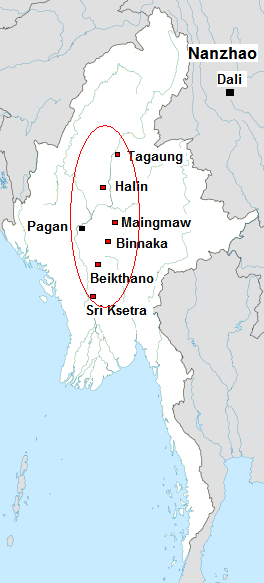Civilización pyu
| ||||
|---|---|---|---|---|
| Civilización | ||||
 | ||||
| Alministración | ||||
| Xeografía | ||||
| Coordenaes | 22°28′12″N 95°49′07″E / 22.47°N 95.818611°E | |||
 | ||||
| Patrimoniu de la Humanidá — UNESCO | |
|---|---|
 Pagoda Bawbawgyi en Sri Ksetra | |
| Llugar |
|
| Criterios | Cultural: ii, iii, iv |
| Referencia | 1444 |
| Inscripción | 2014 (XXXVIII Sesión) |
| Área | Asia y Pacíficu |
La civilización pyu foi un conxuntu de pequeños reinos y ciudaes-estáu que se desenvolvieron ente los sieglos II e.C. y XI d. C., ocupando la zona central de l'actual Birmania. Estos pequeños Estaos fundar cola llegada a Birmania de falantes de llingües pyu, que les sos invasiones enmarcar dientro de les migraciones tibetano-birmanes. Tres cerca de 1200 años de civilización pyu, la estensión territorial en redol al añu 1050 del reinu de Pagan, que'l so orixe atopar nel sieglu IX, supunxo'l fin del denomináu mileniu pyu (consideráu l'equivalente a la Edá del Bronce en Birmania) y l'empiezu del periodu de los reinos clásicos birmanos.
En xunu de 2014, la Unesco escoyó como Patrimoniu de la Humanidá los xacimientos de los trés antigües ciudaes de Halin, Beikthano y Sri Ksetra cola denominación Ciudaes antigües de Pyu tomando los restos de les construcciones en lladriyu, les muralles y los fosos de dicha ciudaes que son testimonios de los reinos de Pyu.[1]
Referencies[editar | editar la fonte]
- ↑ Unesco (22 de xunu de 2013). «Myanmar inscribe'l so primer sitiu na Llista del Patrimoniu Mundial» (castellanu). Unesco.org. Consultáu'l 24 de xunetu de 2014.
Bibliografía[editar | editar la fonte]
- Aung-Thwin, Michael (1996). «Kingdom of Bagan», Gillian Cribbs: Myanmar Land of the Spirits. Guernsey: Co & Bear Productions. ISBN 0-9527665-0-7.
- Aung-Thwin, Michael (2005). The mists of Rāmañña: The Legend that was Lower Burma, illustrated, Honolulu: University of Hawai'i Press. ISBN 0-8248-2886-0, 9780824828868.
- Charney, Michael W. (2006). Powerful Learning: Buddhist Literati and the Throne in Burma's Last Dynasty, 1752–1885. Ann Arbor: University of Michigan.
- Cooler, Richard M.. «The Art and Culture of Burma». Northern Illinois University.
- Hall, D.G.Y. (1960). Burma, 3rd, Hutchinson University Library. ISBN 978-1-4067-3503-1.
- Harvey, G. Y. (1925). History of Burma: From the Earliest Times to 10 March 1824. London: Frank Cass & Co. Ltd.
- Htin Aung, Maung (1967). A History of Burma. New York and London: Cambridge University Press.
- Hudson, Bob (March 2005), «A Pyu Homeland in the Samon Valley: a new theory of the origins of Myanmar's early urban system», Myanmar Historical Commission Golden Jubilee International Conference, http://acl.arts.usyd.edu.au/~hudson/BH2005Jan.pdf
- Lieberman, Victor B. (2003). Strange Parallels: Southeast Asia in Global Context, c. 800–1830, volume 1, Integration on the Mainland. Cambridge University Press. ISBN 978-0-521-80496-7.
- Moore, Elizabeth H. (2007). Early Landscapes of Myanmar. Bangkok: River Books. ISBN 974-9863-31-3.
- Myint-O, Thant (2006). The River of Lost Footsteps--Histories of Burma. Farrar, Straus and Giroux. ISBN 978-0-374-16342-6, 0-374-16342-1.
- Stargardt, Janice (1990). The Ancient Pyu of Burma: Early Pyu cities in a man-made landscape, illustrated, PACSEA. ISBN 1-873178-00-X, 9781873178003.
- Thein, Cherry (14 de payares de 2011). «Pyu burial site discovered at Sri Ksetra». The Myanmar Times. http://www.mmtimes.com/2011/news/601/news60108.html.
